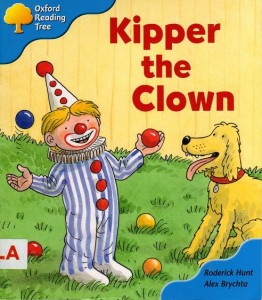curriculum EFL eikaiwa ES Jelly and Bean phonics readers Reading
by sendaiben
5 comments
Follifoot Farm (previously: Jelly and Bean) phonics readers
I can’t think of a better series to start my readers roundup.
There is so much I like about Follifoot Farm:
1. it is written, illustrated, printed, and distributed by an individual (a former maths teacher called Marlene Greenwood)
2. it is incredibly well-structured, leading readers through a gentle progression of incrementally more challenging basic phonics constructions
3. the artwork and characters are very appealing
4. the stories are generally interesting -many of them have twists and cute little details
There are currently just over 120 books in the series (our own collection has 145, but that includes discontinued and semi-duplicate books). You can see details of the series here, and worksheets and sample books here.
In my opinion, the first levels are the best. For us, books 1-80 or so are compulsory for our students. Some students choose to continue reading them after that, but the later stories are much more difficult in terms of the language they use. They are perfectly decodable, but it gets harder and harder for students to understand the meaning of the stories.
The earlier books, because of the extremely well-tuned phonics progression and clear pictures, do a great job of easing students into reading.
Starting with ‘a cat’ (the first few books do not have capital letters or punctuation, so they are much less likely to confuse beginning readers), moving through CVC (consonant-vowel-consonant), consonant blends, and vowel blends, this series really is the best thing I have found to bridge the gap between phonics practice and actual reading.
I normally do my best to balance reviews, giving both good and bad points, but in this case there is not much I can say against it. I personally love the books, and after using them with hundreds of students (children and beginner adults), am convinced of their efficacy.
The only thing is that the books are fairly expensive. Bought from the Japanese distributor, they end up costing just under 400 yen each. Buying the full set of 122 books costs 45,000 yen. This would be a considerable commitment for most schools. Add in the fact that you will probably need multiple copies (we have ten full sets!), and it’s a big decision to adopt them. Because of the current exchange rate, buying them directly from the UK could save you money, even after paying the 48% postage.
Another alternative is to buy CDs with digital versions of the books you can use on a computer or screen, or print out yourself. I personally like having the books, but the electronic versions are much cheaper, particularly if you have large classes or a limited budget.
I’m planning to do another post about how we actually use the readers with our students, so I won’t go into details here. I’d also love to hear from other teachers familiar with the series. Do you like it as much as I do? If not, why? It would be great to get some balance in the comments.

Admin EFL extensive reading kids language courses readers Reading Review teaching
by sendaiben
6 comments
Children’s Readers Roundup
Rather than try to come up with a new topic every couple of days, I have decided to review all the children’s readers we use and write one post for each series. That should keep me going for a while, and hopefully turn into a useful resource for teachers considering their next purchase.
I have written briefly about a couple of series on the blog:
Story Street (10.12.22)
Oxford Reading Tree (10.10.23)
SRA (09.08.13)
but they were all fairly superficial posts. I plan to go much more in-depth this time around. There will also be a big comparison post at the end.
I’m quite excited about this project.
There is just one concern, which is the legality of posting content as part of a review. Does anyone know what is acceptable with regards to posting photos (of text, artwork, the outside cover of the book, CDs, etc.) taken by me?
I will probably contact the publishers just to make sure, but any advice or experiences would be much appreciated!
curriculum EFL expectations extensive reading language courses Language learning readers Reading self-study teaching theory university
by sendaiben
5 comments
Extensive Reading, Goals, and Benevolent Tyranny
I received an email from Tom Robb this morning, creator of the Moodle Reader (a fantastic free resource to track and verify student reading within an ER program), very kindly answering some questions I asked him.
Among them he mentioned that I seem to be setting quite ambitious goals for my students in terms of the amount of reading I expect them to do. This isn’t the first time I’ve heard that comment, so I thought this would be a good chance to expand on the topic, as well as discuss a couple of peripheral issues that are pertinent to it.
First of all, in my extensive reading classes at Tohoku University, I require students to read at least 100,000 words in one semester. That is the amount of reading they have to do to pass the course and receive a credit. Beyond that, if they want to get an A or AA grade (the top grade), they have to read much more. Generally to have a chance of getting an AA, students would have to read around half a million words.
Talking to other teachers, I seem to have set the bar rather high.
The thing is, extensive reading (and language learning in general) is a numbers game. It’s not so much about what you do (although doing things that work for you does speed the process up) as it is about how much you do. How much reading do you do. How many words, books, hours? The more you do, the easier it becomes and the more you learn. There is a critical mass involved, too. According to Nishizawa et al. the turning point for their students came after they had read 300,000 words: after that, they found it much easier to read in English.
The flipside of this is that if you don’t read enough, you probably won’t reach this breakthrough moment.
I push my students hard. They are academically gifted, often motivated, and understand the reasons why they have to work so hard. The most committed report spending more than ten hours a week reading for my class.
None of my students failed to reach the 100,000 word level, and most of them did much better. I’m very proud of them.
There are several reasons I push them so hard. One is that they have a lot of catching up to do: very few of them have done much in the way of extensive reading or listening in their English learning so far. They have a great deal of knowledge about English (in the form of grammar patterns and knowing a Japanese translation for a lot of English words), but not as much familiarity with it (reading or listening fluency, knowledge of collocations, sense of register). They need a lot of input to catch up to their peers in other countries.
I’m also hoping to get them started on a habit of English. Creating a habit is often just a matter of gradually integrating it into your daily routine, so that it becomes ingrained, like brushing your teeth or reading a newspaper in the morning. If my students are going to have a shot at becoming proficient English users, they are going to have to make it a part of their lives. A semester is not a very long time, but I hope that at least some of my students will catch the reading bug and continue reading in English for an hour or two each week after the course is over.
Finally, I set ambitious goals for my students because they are very bright and very busy.
Busy people naturally try to optimise their time, spending it on more urgent or important things, while sometimes neglecting the less urgent but more important goals (getting mired in quadrant three from the Seven Habits of Highly Effective People) . I am the same -I know that I should be spending an hour or so a day learning Thai, but instead find myself catching up on grading because it is due tomorrow morning. By having high expectations of my students and setting them concrete goals I hope to push them a little closer towards the goal of English proficiency.
Not all of them will continue reading, of course. But some will. And even the ones that don’t will find themselves reading a little bit more quickly and easily.
Do you agree with setting ambitious targets? Can it sometimes be harmful? I’d love to hear from you in the comments below.
curriculum EFL eikaiwa expectations kids language courses Language learning readers Reading school management self-study teaching university
by sendaiben
7 comments
5 Top Extensive Reading Hacks for Teachers
I am a huge fan of extensive reading (ER), and believe it is an essential part of any language course. Also known as FVR (free voluntary reading, although the voluntary part is kind of optional, as you’ll see below), it basically consists of reading a large amount of easily understood text. This usually delivers fairly painless language acquisition, as well as the ancillary benefits of enjoyment and incidental content learning. You can learn more about ER at the Extensive Reading Foundation page.
I’ve been doing ER with Japanese learners since 2004, and have found a few techniques over the years that make a big difference to learners’ progress both inside and outside the classroom.
#1 have students read in class
This is so important. Many students lead busy lives, and reading in English will have a low priority. By giving them time to read in class, we ensure that all students are having the chance to spend at least some time engaged in this crucial activity. Additionally, if students start to read a book in class, the chances that they will then finish it after class increase dramatically.
#2 set achievable goals
Let’s face it, students rarely choose to read in English purely for pleasure. They may do it because they find it useful or because they believe it is a good way to learn, but most of them do so because their teacher asked them to. Finding achievable goals that push your students to read more and more without overburdening them is the key to a successful ER program.
#3 sell reading to your students
This is the foundation that the previous point rests on. It is essential that students understand why they are reading before they start. The principles of ER, guidelines and advice, as well as expected results should be made as clear to the students as possible. If students understand and, more importantly, believe in ER as a method, they are far more likely to succeed.
#4 recommend specific books
Introduce books to students based on their interests and your own. Hopefully you’ll have read all your readers and will be able to recommend specific books based on genre, level, length, and other factors. A personal recommendation makes it much more likely that students will read, and also more likely that they will find a book they like.
#5 give students time to talk about their reading
This may be the most important tip of all. Assuming that most of your students are participating actively in the program, you can harness the power of peer pressure and social proof. If students have time to talk to each other about the books they have been reading, they can share book recommendations and inspire each other to read more. Of course, if many of your students are not participating actively, you may wish to avoid this, as you run the risk of having them drag down the more active ones. It’s just a matter of reading your class to see if this would be beneficial or not.
So, what do you say? Any other good tips for running an ER class or program?
conference curriculum EFL eikaiwa expectations kids Language learning Oxford Reading Tree presentations readers Reading teaching theory Uncategorized
by sendaiben
2 comments
Oxford Teaching Workshop in Niigata (March 12th)
I’ll be presenting again as part of the Oxford Teaching Workshop 2011. It’ll be taking place in Niigata, at the Coop City Hanazono, on Saturday March 12th.
The lineup is as follows:
| Saturday, March 12, 2011 | |
| 10:00-10:30 | Registration |
| 10:30-11:20 | Reading in Class: Opening the Door to an English World Ben Shearon |
| 11:40-12:30 | Teaching Ideas to Add Variety and Spice to your Lessons Ritsuko Nakata |
| 12:30-13:30 | Lunch |
| 13:30-14:20 | What you need to know for Shogakko Eigo Katsudo! Setsuko Toyama |
| 15:00 | Doors Close |
I’ll be talking mainly about using the Oxford Reading Tree and other story books in class. Hope to see some of you there!




